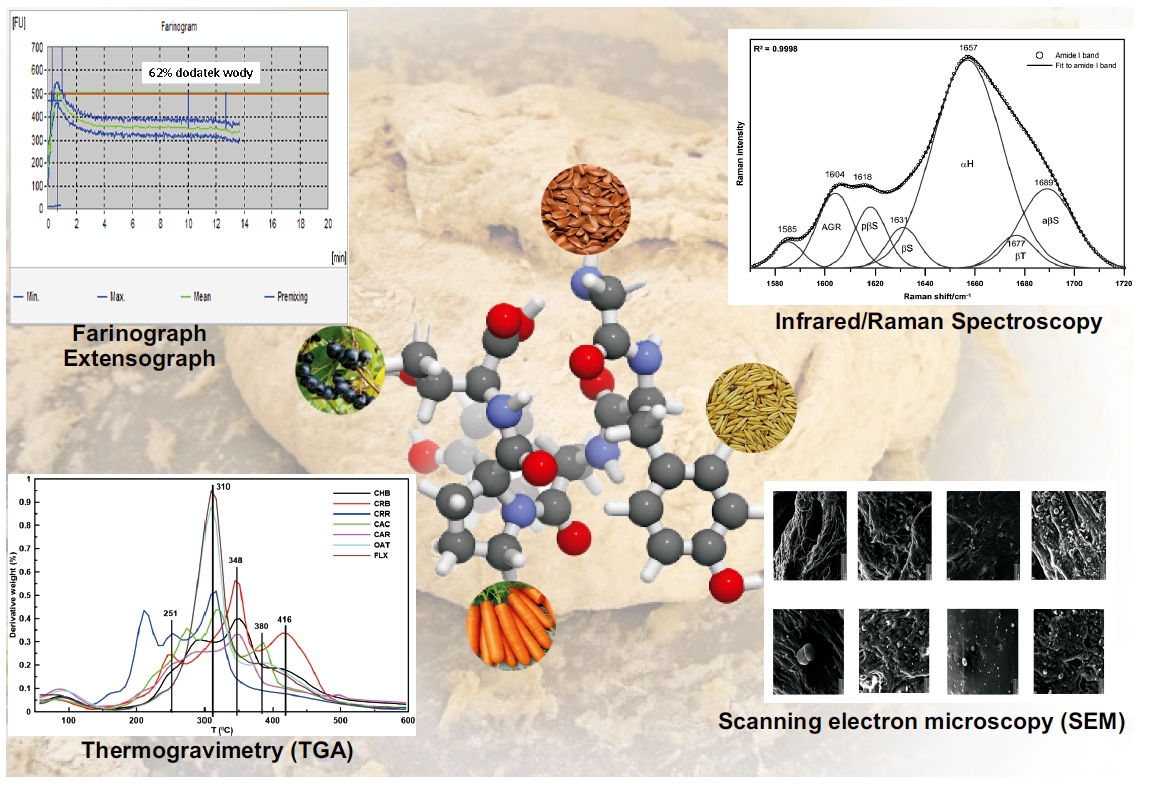Leader: dr Agnieszka Nawrocka
Team: dr hab. Antoni Miś, prof. IA PAN; dr hab. inz. Robert Rusinek; dr Marek Gancarz; dr Tadeusz Rudko; Zbigniew Niewiadomski
Nowadays, the consumers demand for the dietary fibre-enriched products of appropriate taste, texture, smell and appearance as a result of growing consumers’ awareness concerning the health benefits from consumption of this kind of products. The dietary fibre supplements can be added to bread to increase the dietary fibre intake since the bread is a principal component of western diets and thus a convenient way to deliver fibre polysaccharides and antioxidants. However, the main problem of dietary fibre addition in baking is significant reduction of bread quality e.g. decrease in loaf volume, gritty texture and unsuitable taste and mouthfeel (Collar et al., 2007). A wheat bread quality is connected with the structure of gluten proteins (gliadins and glutenins) which participate in the formation of continuous viscoelastic network within dough. Addition of different chemical compounds (e.g. water-soluble and water-insoluble polysaccharides, anthocyanins, phenolic acids which are components of dietary fibre supplements) to the dough disturbs the gluten network by creating new hydrogen bonds and causing changes in disulphide bridges conformation. It leads to folding or aggregation of protein complexes and results in forming of network characterized by different mechanical properties. The objective of our studies is to determine changes in rheological properties of the bread dough and structure of gluten proteins caused by the addition of dietary fibre supplements in different contents (0-20%) and connect them with the chemical composition of the dietary fibres. The dough quality is studied by using farinographic and extensographic techniques (Miś, 2011; Miś & Dziki, 2013; Nawrocka et al., 2016a), whereas spectroscopic (FTIR and Raman spectroscopy), thermal (thermogravimetry) and microscopic (scanning electron microscopy) techniques are used to determine changes in structure of gluten proteins (Nawrocka et al. 2015, 2016a, 2016b).

References
- Collar C., Santos E., Rossell C.M. Assessment of the rheological profile of fibre-enriched bread doughs by response surface methodology. Journal of Food Engineering 2007, 78, 820-826.
- Miś A. Interpretation of mechanical spectra of carob fibre and oat-wholemeal-enriched wheat dough using non-linear regression models. Journal of Food Engineering 2011, 102, 369-379.
- Miś A., Dziki D. Extensograph curve profile model used for characterising the impact of dietary fibre on wheat dough. Journal of Cereal Science 2013, 57, 471-479.
- Nawrocka A., Szymańska-Chargot M., Miś A., Ptaszyńska A.A., Kowalski R., Waśko P., Gruszecki W.I. Influence of dietary fibre on gluten protein structure – a study on model flour with application of FT-Raman spectroscopy. Journal of Raman Spectroscopy 2015, 46, 309-316.
- Nawrocka A., Miś A., Szymańska-Chargot M. Characteristics of relationships between structure of gluten proteins and dough rheology – Influence of dietary fibres studied by FT-Raman spectroscopy. Food Biophysics 2016a, 11, 81-90.
- Nawrocka A., Szymańska-Chargot M., Miś A., Kowalski R., Gruszecki W.I. Raman studies of gluten proteins aggregation induced by dietary fibres. Food Chemistry 2016b, 194, 86-94.
